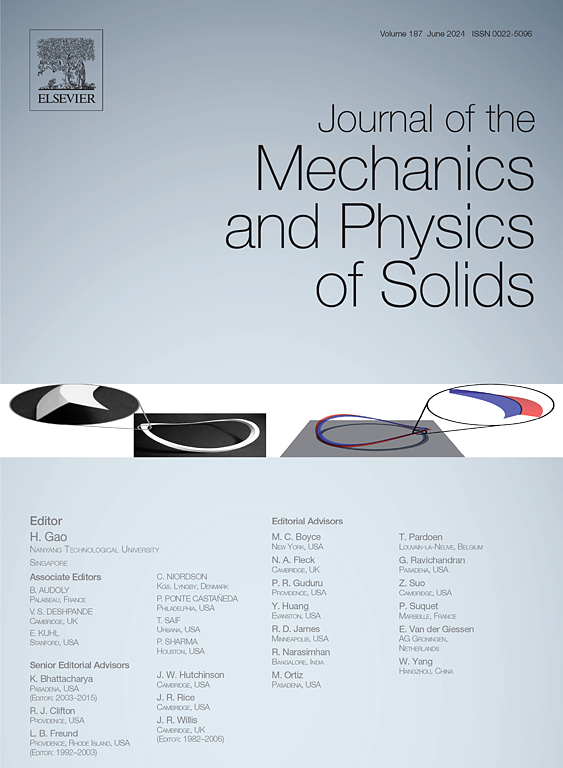随机分布缺陷弹性场中的位错
IF 6
2区 工程技术
Q2 MATERIALS SCIENCE, MULTIDISCIPLINARY
引用次数: 0
摘要
近年来,人们对随机固溶体中的位错行为重新产生了兴趣,并讨论了几种模型,其中将随机合金视为包含随机分布的膨胀和压缩中心的有效介质。更一般地说,金属和合金中缺陷的排列总是以统计无序为特征,许多缺陷的应力场和应变场叠加产生的波动场也是如此。为了建立与这些场相互作用的位错动力学模型,需要对位错能量格局和相关构型力进行统计描述,以及在不同长度和形状的位错段上粗粒化这些力的方法。在这种情况下,如何正则化与位错和其他缺陷有关的高度奇异应力场的问题就出现了。本文提出了一种基于奇异位错与其他缺陷(包括溶质,模拟为点状膨胀中心)和其他位错之间的相互作用能和相互作用力的方法。我们用相互作用能量和相互作用力的概率密度以及相应的空间相关函数来描述相互作用。我们还考虑了位错核正则化的影响,或者用连续分布的Burgers向量,或者用Helmholtz型梯度弹性的形式来表达正则化的能量泛函。我们证明了随机分布缺陷产生的应力场服从一般的非高斯统计,并讨论了位错运动的意义。本文章由计算机程序翻译,如有差异,请以英文原文为准。
Dislocations in the elastic fields of randomly distributed defects
In recent years, the behavior of dislocations in random solid solutions has received renewed interest, and several models have been discussed where random alloys are treated as effective media containing random distributions of dilatation and compression centers. More generally speaking, the arrangement of defects in metals and alloys is always characterized by statistical disorder, and the same is true for the fluctuating fields that arise from the superposition of the stress and strain fields of many defects. In order to develop models for the dynamics of dislocations interacting with such fields, a statistical description of the dislocation energy landscape and the associated configurational forces is needed, as well as methods for coarse graining these forces over dislocation segments of varying length and shape. In this context the problem arises how to regularize the highly singular stress fields associated with dislocations and other defects. Here we formulate an approach which is based upon evaluating the interaction energies and interaction forces between singular dislocations and other defects including solutes, modeled as point-like dilatation centers, and other dislocations. We characterize the interactions in terms of the probability densities of interaction energies and interaction forces, and the corresponding spatial correlation functions. We also consider the effects of dislocation core regularization, either in terms of continuously distributed Burgers vectors or by using the formalism of gradient elasticity of Helmholtz type to formulate a regularized energy functional. We demonstrate that the stress fields arising from randomly distributed defects obey in general non-Gaussian statistics, and discuss implications for the motion of dislocations.
求助全文
通过发布文献求助,成功后即可免费获取论文全文。
去求助
来源期刊
CiteScore
9.80
自引率
9.40%
发文量
276
审稿时长
52 days
期刊介绍:
The aim of Journal of The Mechanics and Physics of Solids is to publish research of the highest quality and of lasting significance on the mechanics of solids. The scope is broad, from fundamental concepts in mechanics to the analysis of novel phenomena and applications. Solids are interpreted broadly to include both hard and soft materials as well as natural and synthetic structures. The approach can be theoretical, experimental or computational.This research activity sits within engineering science and the allied areas of applied mathematics, materials science, bio-mechanics, applied physics, and geophysics.
The Journal was founded in 1952 by Rodney Hill, who was its Editor-in-Chief until 1968. The topics of interest to the Journal evolve with developments in the subject but its basic ethos remains the same: to publish research of the highest quality relating to the mechanics of solids. Thus, emphasis is placed on the development of fundamental concepts of mechanics and novel applications of these concepts based on theoretical, experimental or computational approaches, drawing upon the various branches of engineering science and the allied areas within applied mathematics, materials science, structural engineering, applied physics, and geophysics.
The main purpose of the Journal is to foster scientific understanding of the processes of deformation and mechanical failure of all solid materials, both technological and natural, and the connections between these processes and their underlying physical mechanisms. In this sense, the content of the Journal should reflect the current state of the discipline in analysis, experimental observation, and numerical simulation. In the interest of achieving this goal, authors are encouraged to consider the significance of their contributions for the field of mechanics and the implications of their results, in addition to describing the details of their work.

 求助内容:
求助内容: 应助结果提醒方式:
应助结果提醒方式:


